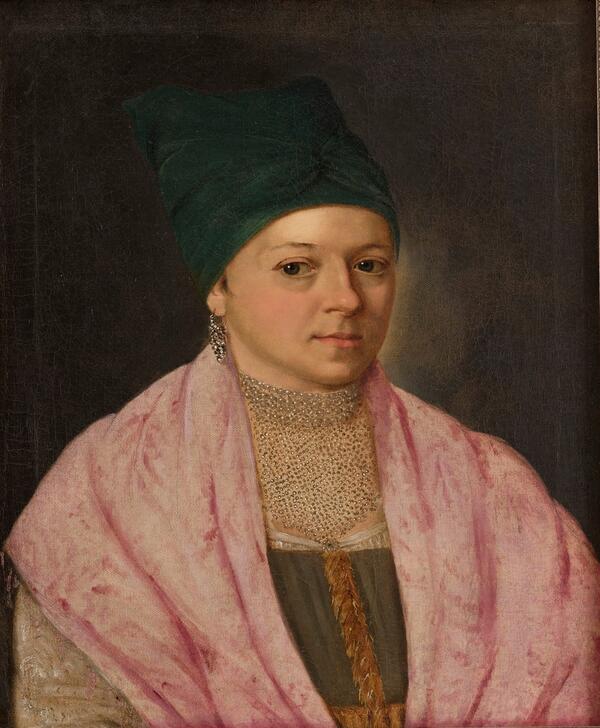The portrait depicts an unknown Murom merchant’s wife in an attire typical for the 1820s — 1830s. She is wearing a thin muslin shirt with wide sleeves; at the collar the edge of the shirt is connected to the pearl net of the necklace with the help of an agrafe — a special brooch clasp. The merchant’s wife put on a small fur-lined cloak (dushegreika-yepanechka) over the shirt; it is made of green fabric with a galloon — gold webbing — along the edge. The artist depicted the woman with a pearl earring in her right ear.
The merchant’s wife has a silk shawl with a pinkish tone and embossed design on her shoulders. Her hair is hidden under a silk green headscarf. The ends of the scarf are tied with a bow over her forehead. This way of wearing scarves related them to the traditional headdress worn by married women — povoynik.
The model’s head is turned to the left (to the right of the viewer): this means that the portrait could be paired with a male portrait. In this case, the image of the wife was on the right hand of her husband, not on the left, as it was customary in traditional Russian paired portraits of merchants.
It is commonly believed that merchant’s wives mainly from the northern governorates of Russia posed in such clothes as shown in the portrait. In those regions, ceremonial and festive clothes were used in everyday life much longer than in central governorates — Moscow, Vladimir and Yaroslavl Governorates. However, the Murom portrait from the museum’s collection depicts a slightly modified female ceremonial attire: the model’s headdress is not a kokoshnik (which was worn in Murom until the Patriotic War of 1812), but a silk headscarf tied in a “merchant style”. Thus, Murom historian and chronicler, Alexey Titov, wrote in 1840:
The merchant’s wife has a silk shawl with a pinkish tone and embossed design on her shoulders. Her hair is hidden under a silk green headscarf. The ends of the scarf are tied with a bow over her forehead. This way of wearing scarves related them to the traditional headdress worn by married women — povoynik.
The model’s head is turned to the left (to the right of the viewer): this means that the portrait could be paired with a male portrait. In this case, the image of the wife was on the right hand of her husband, not on the left, as it was customary in traditional Russian paired portraits of merchants.
It is commonly believed that merchant’s wives mainly from the northern governorates of Russia posed in such clothes as shown in the portrait. In those regions, ceremonial and festive clothes were used in everyday life much longer than in central governorates — Moscow, Vladimir and Yaroslavl Governorates. However, the Murom portrait from the museum’s collection depicts a slightly modified female ceremonial attire: the model’s headdress is not a kokoshnik (which was worn in Murom until the Patriotic War of 1812), but a silk headscarf tied in a “merchant style”. Thus, Murom historian and chronicler, Alexey Titov, wrote in 1840:


